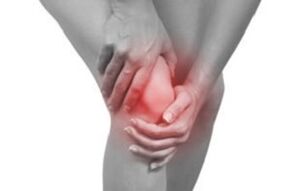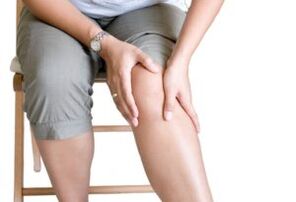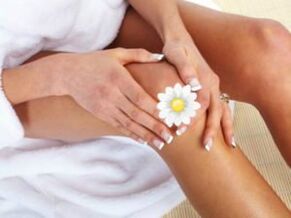
Of all the joints in the human body, knee pain is the most common complaint of humans. The knee joint is complex, it carries a heavy load during different types of physical activity, therefore, there can be many reasons for pain in it. Knee pain, even if it occurs occasionally and resolves on its own, should not go unnoticed.
Knee pain, whatever the severity, significantly impairs quality of life. There is no joy from your favorite kind of outdoor activity, efficiency decreases and a simple shopping trip becomes a problem.
In this article, we will look at what to do if your knee joints ache, how to deal with them and if it is possible to get rid of the pain in the knees forever - the last question is especially important for seniors who consider sedentary movement andjoint pain syndrome necessary companion of age.
Pain diagnostics
- It is necessary to know the nature of the pain. The pain can be sharp, burning, stabbing, aching.
- Eliminate the conditions for the onset of pain - at night, after exercise, while walking, in the morning, a sudden sharp pain.
- There were other signs of joint damage: edema, hyperemia (redness), joint deformity, stinging, limited mobility.
- Check for a history of infection, stress, leg injury or increased physical activity.
- Have an organ examination at a medical and preventive institution (LPU) - blood test, X-ray diagnosis, synovial fluid analysis.
Causes of knee pain
There are more than 200 joint pathologies, most of which are accompanied by more than just pain. Only on the basis of a set of symptoms and tests can you determine what is causing your knee pain.
Traumatic pathology
In traumatic pathologies, knee pain occurs with joint injuries (blows, falls, prolonged joint pressure - typical of athletes) or with general body ailments.
Let's look at the main traumatic pathologies.
Knee fracture
Fracture or displacement of the patella, fractures of the condyles of the femur and / or tibia. When you fall from a height on your knees, in case of car accidents etc.
The victim experiences an acute sharp pain at the time of the impact, over time the pain does not stop, it may become slightly weaker, but intensifies with pressing or walking.
The joint swells, deforms, fills with blood (hemorrhage), the knee does not bend and the patella becomes unusually mobile.
Dislocated knee

It is characterized by the displacement of the bones of the joint between them. Dislocation of the knee joint is of varying complexity (complete, incomplete, complicated by soft tissue rupture, etc. ).
The usual dislocation occurs as a result of a knee injury or as a result of a congenital anomaly: weakness or excessive elasticity of the ligaments, flat sliding paths of the femur at the joint, excessively high knee position.
A dislocation of the knee joint is a very serious injury and if you do not take care of it in time, it can all lead to serious complications. Knee dislocation is the most painful of all types, although it is a rare occurrence.
Serious injuries such as dislocations must be treated in medical institutions, so there should be no independent intervention. This is what traumatologists do.
Sprain, rupture of tendons, ligaments
Depending on the degree of damage (some ruptures of individual fibers, incomplete rupture, complete rupture), there are symptoms: stinging and cracking during movement, bruising below the rupture point, limitation of bending-extension of the joint, swelling in the knee, very mobile joint(with complete breakage of the links). The pain is sharp and intense, but with a small injury it may not appear immediately, but after a while.
Bursitis
Inflammation of the periarticular follicle due to trauma, infections, metabolic disorders, autoimmune disease. It often occurs in athletes and overweight people. The knee is swollen, the pain varies in intensity, but increases with effort and at night.
Meniscus tearing
It can be the result of trauma or degenerative changes in the cartilage tissue. Acute trauma is characterized by severe pain, swelling and limited mobility. The symptoms of degenerative changes are mild.
Diseases of the joints
Knee pain can be a symptom of a medical condition.
We have quotedThe most common diseases with knee pain syndrome:
Rheumatism
The diagnosis is much less common than in the 19th and 20th centuries. This is due both to the discovery of penicillin (and subsequently to the production of other antibiotics) and to the low diagnostic potential in the past, when almost all joint diseases were attributed to rheumatism.
A characteristic sign of rheumatism is the alternating pain in the joints: first, one joint becomes inflamed and then the other. For example, the pain in the knee subsides, but appears in another large joint (elbow, hip).
Rheumatism is more common in children and adolescents, the disease develops after streptococcal infection of the upper respiratory tract.
Note: advanced rheumatism leads to damage to the heart (rheumatic heart disease) or to the nervous system (chorea).
Reactive arthritis
It is more common in people of reproductive age, as inflammation of the joints is more often caused by pathogenic germs that enter the human body sexually.
Less commonly, reactive arthritis is caused by infections of the gastrointestinal tract or nasopharyngeal infectious inflammation (sore throat, flu). After 1-4 weeks after the illness, the patient notices that his legs start to ache at night.
Both large joints (knees, ankles) and small ones (sore or sore big toe) can become inflamed and painful. Knee pain is accompanied by swelling and / or redness.
Sometimes the symptoms include conjunctivitis (inflammation and pain in the eyes), keratoderma (thickening of the skin on the soles).
Reiter syndrome
Urethritis (frequent, painful urination) and bowel disorders combine the symptoms of common reactive arthritis.
Osteoarthritis
Disease of the elderly. Periodically the knees ache at night "for the weather". The load on the joint (long walk) increases the pain, swelling and impairs the mobility of the joint.
After resting and warming up, the pain disappears.
Baker cyst
Swelling in the back of the knee, which causes a feeling of contraction, difficulty in movement.
Osteochondritis (Köning disease)
The cartilage that covers the bone comes off, the aching knee hurts and when the piece is completely detached, the movement of the joint is blocked.
Osgood-Schlatter disease
It is most often diagnosed in adolescents. Knee pain increases when we go up and down stairs, squatting.
Rheumatoid arthritis
An autoimmune disease, the mechanism of which is not clear. It is observed that the starting conditions are the usual load list in the immune system: from stress and infection to hypothermia. Immune bodies that attack their own cells cause inflammation of the joint, especially the articular joint of the articular system.
Under the influence of an attack by immune cells, the membrane swells, grows in volume and then begins to grow in nearby cartilage and bone tissue. The result of the procedure is pain in the knee joints, which becomes unbearable in the second half of the night.
The disease lasts for years, the treatment consists of non-steroidal anti-inflammatory drugs, corticosteroid hormones, gold preparations, immunosuppressants, antimalarial drugs.
It results from improper metabolism. Due to alcohol abuse, "purine" products (meat, smoked meats, pickles).
Blood uric acid is deposited in the joints in the form of sodium uric acid crystals. Increasing "deposits" gradually affect the mobility of the joint, severe pain attacks occur, the time between attacks is gradually reduced.
Vascular pain in the knees is characterized by a sensation of pulling along the vein, sometimes patients notice an acute tingling sensation.
Only a doctor, after a thorough examination, can tell why the knee hurts, if there was no obvious injury. It is unwise to rub the knee joint with a treatment that "helped a neighbor". After all, what helps heal a joint injury can trigger an exacerbation of the disease's autoimmune mechanism.
Treatment of knee pain
The doctor chooses a treatment regimen depending on the diagnosis.
Therapeutic measures aim to combat:
- with the cause of the disease - infection, tumor, abnormal metabolic processes, failure of the immune system.
- with pain syndrome - symptomatic treatment includes analgesics, intra-articular blockades.
- with degenerative processes - drugs with chondroprotectors help to restore the cartilage tissue of the joint.
If necessary, resort to surgery, endoprosthesis, use physiotherapy and therapeutic exercises for the joints.
Pain relief products
Checklist for those with knee pain - what you need to do to relieve the condition.
| Cause of pain | What to do |
|---|---|
| Pain that clearly results from trauma | Provide joint and limb immobility, ice or a cold compress on the knee. Immediate medical care. |
| Arthritis pain (reactive, rheumatic, etc. ) | Special treatment with antimicrobial and anti-inflammatory drugs is prescribed only by a doctor. For night pains, you can apply a warming compress, ointments based on bee venom. |
| Pain in arthropathy (post-traumatic, elderly, overweight people) after exercise or at night | Any heating compresses with herbal tincture, rubbing in ointments with coarse preservatives. |
Severe joint pain is relieved by non-steroidal anti-inflammatory drugs (NSAIDs).
But most patients (overweight, age-related joint changes) should not think about what to do with the pain if they took the minimum precautions:
- Proper nutrition with sufficient amount of calcium, vitamins, fight against excess weight.
- Reduce the intense pressure on the joint until the change of work, if it consists of "standing on your feet" all day.
- Systematic physical therapy to strengthen muscles and ligaments - a good muscular corset reduces the load on the bones.
Joint diseases can develop over the years and lead to a significant deterioration in quality of life. An early visit to a doctor and an arsenal of folk remedies will help you maintain the joy of movement until old age.
Common home remedies - folk remedies
The lessons use homemade recipes for ointments and compresses based on natural ingredients - this is the only way to achieve a lasting result.
7 simple folk remedies for knee pain:
- Cabbage leaves. On a fresh leaf, cuts are made so that the juice comes out. Put a spoonful of honey in the middle and apply this "compress" on the knee. The sheet is fastened with a bandage. Wear a bandage all day or do the procedure at night. The leaves of burdock and plane tree are used in a similar way.
- Propolis tincture for arthritis. If the knees "twist" at night (the causes of dull pain can be from the change of weather to the stress on the legs), lubricate the joint with a mixture, rubbing it into the skin until it dries. If the knees are very painful, then make a complete compression: moisten the soft tissue with tincture and apply it to the joint, cover it with a film and wrap it with a handkerchief. The tool is also used to heat the joint if a sore throat has a cold. Similarly, they use tinctures of natural stimulants: aloe, kalanchoe, mummy, dead bee.
Great:biologically active substances can not be used if the disease is autoimmune in nature. Stimulants activate the immune system and aggravate the disease.
- Gelatin compress. A piece of gauze soaked in hot water is squeezed, 1 teaspoon is poured in the center. gelatin, spread on the joint, wrapped in foil and wrapped. Repeat the procedure for 14 days at night. The product promotes nutrition of the joints and regeneration of cartilage.
- A mustard compress will help if your knee hurts a lot. Take the honey and the dry mustard in equal proportions, add hot water and salt until a porridge texture is formed. Lubricate the knee with a mixture, apply with a cloth with a film and bandage. Exposure time 20–40 minutes, Remove in case of severe burning sensation. A mustard compress is used for pain every other day.
- In order not to hurt the feet, a medicine is prepared for oral administration: the gelatin is mixed in 0. 5 liters of water in the evening, heated in the morning until it dissolves completely. The mixture is taken before meals for ¼ - 1/2 glass, drink for a month.
- Internal goat fat (100 g) is mixed with balm "Zvezdochka" (1 jar), the resulting ointment is rubbed for venous pain and knee joints.
- Kefir mask. 0, 5 liters of kefir bread crumbs, add 1 tbsp. soda. The mixture is insisted for 6 hours. The liquid is then filtered, moistened with gauze and compresses overnight for several days, until the pain disappears.

It is recommended to apply regular home treatment with folk remedies, in combination with traditional medicine and modern methods. Do not wait until the disease is already firmly established and has stated that it has severe pain, deformity of the joint. Early visit to the doctor will speed up recovery, while the chronic form of the disease is more difficult to cure.
Note:Treatment with folk remedies is allowed only with the approval of a doctor, after examination and diagnosis.


















































